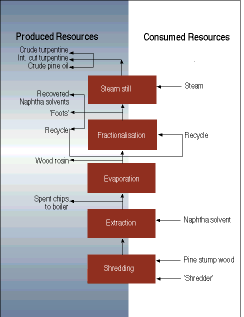
An increasing number of leading food manufacturers worldwide are abandoning 'make-do' production systems in favour of an approach that was designed from the ground up to cater for the complex environment of multiple outputs, fractional batches and recycling processes where an end-product may require itself as raw material.
In the previous article, we saw how a production model, by making provision for all produced and consumed resources, helps to accurately allocate overheads in complex continuous and batch manufacturing environments. We also saw how production models easily accommodate the planning and reporting complexities of batch factors. Another important aspect that was discussed is the importance of having production systems that are designed from scratch to handle inverted bills of material to cater for the multiple output environment of food manufacturers. What follows clearly illustrates how production models cope with multiple outputs as well as the recycling process.
A multiple output example
Consider the process of extracting turpentine from stumps of pinewood. Solvents are added to the shredded wood and then, through a process of fractionation and distillation, multiple outputs are produced including different grades of turpentine, wood, rosin, recovered solvents and other by-products (see Figure 1).

In this example, the manufacturer needs to plan demand for the crude pine oil; the intermediate cut of terpenes and the crude turpentine outputs. The wood rosin by-product must also be planned because it is sold as an ingredient to producers of adhesives and paper sizing agents. The planning system must also track the expected produced quantity of spent chips since they are a primary source of fuel for generating the steam required to run the process.
Each different output requires different costing techniques. Total process costs need to be distributed proportionately among graded outputs of the distillation step. In addition, some of the costs involved in the evaporation process need to be distributed to the wood rosin so that wood rosin prices may be developed reflecting accurate actual costs. The spent chips might have an assigned cost value (sometimes referred to as a Net Realisable Value - NRV) reflecting a market-determined value that typically does not fluctuate. Actual production quantities of all of these co-product and by-product outputs need to be reported against the daily production schedule with variance reporting of actual to expected quantities.
How production models manage multiple outputs
Production models enable the user to define all types of outputs as produced resources in a straightforward and simple manner. All outputs are included in the model at the point at which they are produced in the process. In this way, multiple outputs are managed more directly and planned, costed and reported more accurately. Therefore, production models more easily accommodate the complexities of a multiple output process than traditional business planning and control systems.
Production models enable the user to manage master production plans and orders for any produced resources. For the turpentine company in this example, planning considers requirements for graded product at the same time it considers demand for the wood rosin by-product. The benefit of this approach is that the system schedules the necessary production batches to satisfy the requirements for both the co-products and by-products at the same time.
With production models, a user can define production and cost distribution percentages (which may differ) for multiple outputs throughout the process. In the turpentine example, a user might define the expected production distribution of crude pine oil, terpenes and crude turpentine to be 15, 35 and 50% respectively. He may also distribute process costs to the three resources similarly. At the evaporation task, 85% of produced material continues in the process with wood rosin making up the remaining 15%. The relative cost of wood rosin, however, might be based on a different percentage or might even be an assigned value. The production model is also an important tool for simulating the impact of cost fluctuations of raw material inputs on all produced resources.
"Since production models enable you to manage all produced resources, reporting is more straightforward as well," says Ian Huntly, Business Development Manager at Futuristix-Wonderware. "Pick-lists, orders and receipts reflect real requirements. To manage multiple outputs with traditional bill of material systems requires either system workarounds to mask negative requirements for by-product outputs or training to teach people to workaround the system. Both of these approaches increase the risk of system disuse, slows return on investment and lowers the overall value of the investment."
Controlling recycled material
Process operations often include resources that recycle through production. For example, the turpentine manufacturer uses naphtha solvent in the extraction step and recovers solvent produced at the fractionation step in the same process. Most systems do not allow an item to require itself as a component since an infinite loop in the processing logic occurs.
How production models manage recycles
Production models enable users to manage the real world requirement of recycles in process operations more easily. Resources in a production model can be consumed or produced on the same model. Recycles can be accounted for in requirements planning and product costs. Users can define processing rules to balance the need for a recycled input resource with its produced output counterpart.
"Today," continues Huntly, "Wonderware's Protean - a component of ProductionSuite - is still the only off-the-shelf and purpose-built solution for food and beverage manufacturers. Quite apart from its unique feature of being completely developed using object-oriented technology so that customisation can be done without any software modification, Protean was developed with the co-operation of leading food and beverage manufacturers to specifically address their complex and unique needs. Protean helps bridge the gap between Wonderware's realtime, FactorySuite environment and the manufacturing company's high-end business systems. A 'bottom-up' approach that reflects reality rather than wishful thinking."
In the next and final article, we will look at the need for managing all resources as well as multiple formulations.
Mike le Plastrier
(011) 622 8181

© Technews Publishing (Pty) Ltd | All Rights Reserved